Part I >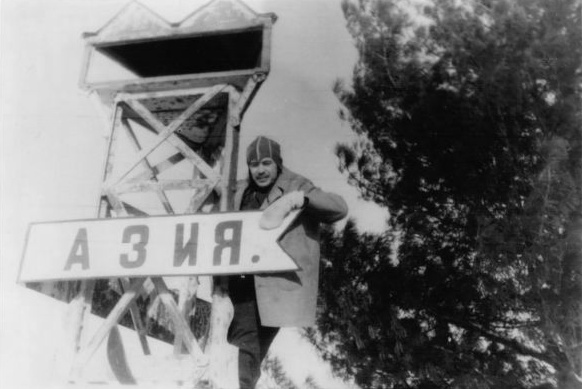
Kolya Thibault at the sign dividing Europe and Asia (no date). Archive Kazantseva M.E. (photo received from Galina Ivanovna Kryachko, Yekaterinburg)
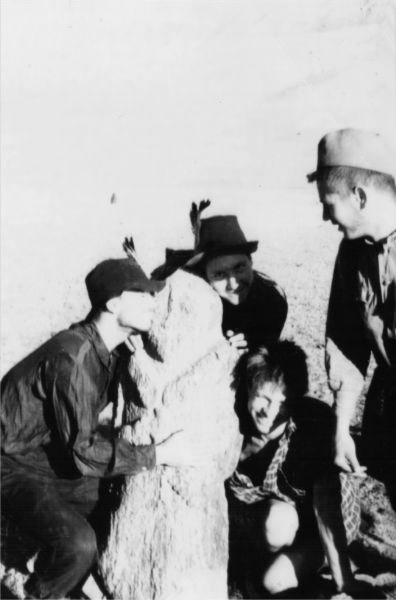
Tourists on a trek. Summer of 1958, Altay. Kolya Thibault - 1st on the left. Archive Kazantseva M. E. (Photo received from Galina Ivanovna Kryachko, Yekaterinburg)
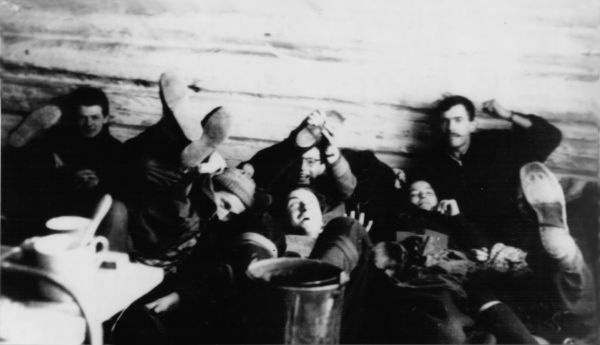
Village of Tyomnoe on Serebryanoy river. An uninhabited barrack. 16-17 February 1958 Kolya Thibault - 1st on the right. Archive Kazantseva M.E. (photo received from Galina Ivanovna Kryachko, Yekaterinburg)
What are your personal thoughts when you look at these hiking photos, where the guys are cheerful and fooling around? Did they have a drink? Do you think if they had alcohol with someone else?
AE: Regarding the alcohol ... I would trust the opinion of people who went to winter hikes at that time, it was customary to take alcohol, or not. As for the photo, it seems to me that this is just a posing to make the pictures more interesting and unusual, a reflection of a cheerful nature and perhaps some inclination towards showing off in Nikolay's case (as noted in the essay by A. Rakitin). It reminds me of the photos that modern people put on social networks.
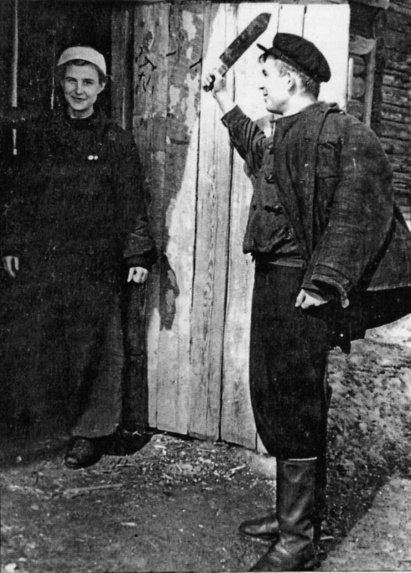
Fooling around in one of the hikes
Was there anyone from your family at the Kolya's funeral? Are there any photos from the funeral? What memories of the funeral are preserved in the family?
MEK: My grandmother Anna Iosifovna, her daughter Olga - my mother, with her husband and two children - we all lived not in Sverdlovsk, but in Kamensk-Uralsky, this is a town 150 km from Sverdlovsk. I can not say if there was someone from our family at the funeral. We do not have a photo from the funeral. And I do not have memories of the funeral. I was then 7 years old, and I was guarded from such terrible impressions. We have a photo of Elizaveta Iosifovna at Kolya's grave.
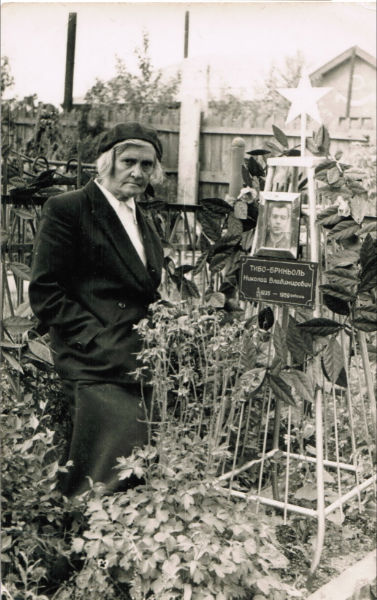
Elizaveta Iosifovna Muzafarova (Thibeaux-Brignolle), Kolya's native aunt , at Kolya's tombstone. Sverdlovsk, the early 60s of the twentieth century. Archive M.E. Kazantseva
Very interesting photo. It can be seen that the monument was different, the photo on the obelisk is different. And the grave itself in relation to the landmark - the roof of the house on that side of the street - is to the right of the house. Gennady Ivanovich Kizilov told a very sad story about the transfer of grave plates of Dyatlov group from their present place deep into the cemetery and a little to the side. He once had a long conversation with V.A. Elovski, who was the custodian of the cemetery before the reconstruction, and who told G.I. Kizilov this story. They specified the distance between the previous series of pyramids, the present series of tombstones, and agreed on a figure of "about three meters", i.е. so tombstones were moved, nobody moved the graves themselves, they remained in place.
AE: I read Gennady Ivanovich opinion on this topic. I will be very happy if this photo is useful to him.
MP: This photo was very useful. Even unique. Probably the only remaining evidence that the current position of the gravestone does not coincide with the position of the grave in 1959. This can be seen well from the preserved house i.e. by its roof, which is visible from behind the fence and is an indisputable landmark. More recently, residents of Yekaterinburg, Darya Babayeva and Sergey Stol have volunteered to help resolve this issue. They went to the Mikhailovskoe cemetery and made this photo of the Kolya gravestone from the very point from which the photo of Elizaveta Iosifovna was made in 1965.
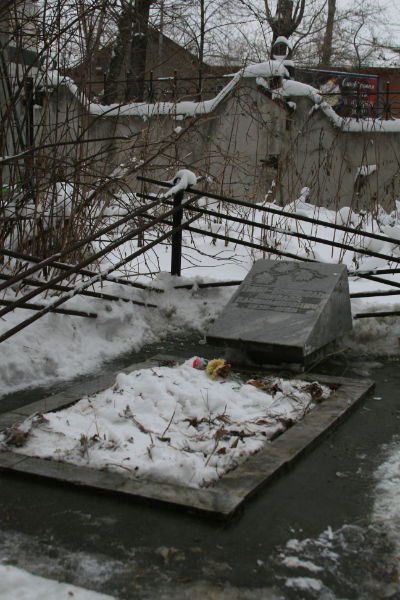
The present gravestone. Photo by S. Shtol and D. Babaeva
Now everyone can compare these photos and draw their own conclusion, whether there were changes in the cemetery, and if the gravestones were laid in the same place as in the year of the burial of Dyatlov group. And the benchmark is well served by the roof of the neighboring house, as it is located in both photos in relation to the tombstone.
Another observation was made at the cemetery: the location of the alleged Dyatlov group graves was cemented into one huge common slab, creating the impression of of an emergency blocks like the once they poured in Chernobyl. Darya said something about this concrete monument left her with the unpleasant feeling, “since when they started spreading concrete slabs over graves, apparently, something there is unclean”.
MP: Were any of kolya's belongings returned to relatives?
There is an entry in the second volume of the Criminal Case, which E.V. Buyanov points out:
"40. Draft:" We received .... Thibault pen knife ... Thibault 008 ...
42. Record:
1. In Thibault checked shirt 8 rubles.
2. Camera Zorkiy with a tripod and broken lens? 488797. 34 frames shot.
16. Pockets. In Thibault windbreaker and trousers pockets a flashlight, a penknife and a Finnish knife, a compass 1 pc.
72. Receipt dated 26.11.59 from Elizaveta Iosifovna Muzafarova, the relative of the deceased Thibeaux-Brignolle, for receiving from Ivanov wrist watches "Pobeda" and photographs (signed by Muzafarova and Ivanov)"
I am personally not convinced that the camera mentioned in this receipt belongs to Kolya or is somebody else's. In the photos from the expedition we see Kolya taking a picture with a camera, but if it is FED, Zorkiy or maybe Pioneer, the members of the Hibina did not come to an uniform conclusion.
MEK: I remember talking about the fact that nothing was returned from things, not even a camera. At that time, the camera was of a great value. But they did not return it. people whisper that all things are infected with a large dose of radiation, so you can not return them to the relatives. About the wrist watches nothing was said, but the camera were in the center of rumors. The only camera that remained in the family was "Mir", which made rather gray, fuzzy pictures. The family asked to be returned Kolya's good camera naming its brand and identifying it among others, but they refused to return it. It's so obvious: there is a receipt from Elizaveta Iosifovna that she has received Kolya's watches. As for the camera, there is no such receipt. If he had forgotten to take the camera with him on the trip, it had to be where Kolya lived. But there was no camera!
MP: So Kolya had a camera in that expedition? What brand?
MEK: I read many times in the memories of Kolya's friends that he was atking very good pictures. Kolya's camera was of good quality. Most likely, it was bought by Vladimir Iosifovich before his arrest. It could be Sharp, FED. It is possible that this was a German brand, which Vladimir Iosifovich brought from Germany, where he once studied. The investigator showed it to aunt Lyusya (that's how Kolya's sister Elizaveta Vladimirovna was called in the family): "Is this yours?" "Yes." After that, the investigator took it to the safe and aunt Lyusya never saw it again.
MP: But why?!?
MEK: The explanation as of why the camera was not returned was that it irradiated with an increased dose of radiation, and it can not be released as a safety precaution.
MP: What are these photographs that the investigator gave to Elizaveta Iosifovna Muzafarova?
MEK: These photos from their last expedition, received by relatives, neither I nor Sergey know anything about. Perhaps only the elder sister of Kolya, aunt Lyusya, took the pictures with her to Kemerovo ... There is nothing in Elizaveta Iosifovna or else my grandmother Anna Iosifovna would have seen the pictures, and I as well. I have seen photos of the the trek only on the Internet. We had only earlier photographs, and then very few.
MP: This is all very strange, what kind of photos were there? Maybe there were photos of Kolya, which the investigator asked for the gravestone and then returned them.
MEK: I'm sure that photos of the last trek were not returned to relatives. In 1959, there was no talk about any photographs in the conversations between Anna Iosifovna and Elizaveta Iosifovna. We can say that they were already elderly and did not take interest in photographs. But Dina (the youngest daughter of E.I.) was very active, curious and liked photography. And she very much involved in the discussion of Kolya's death. But - never and nothing in their photo albums did not appear with the note: "photos issued by the investigator" or "photos from the last trek". In 1968, during the winter holidays, I was in Kemerovo visiting aunt Lyusya and Anastasia Prohorovna (Kolya's mom), and they did not talk about any photos of this trek and didn't show me anything like that. I stayed with them probably for a week.
MP: Probably these were pictures of Kolya from a personal archive of relatives, for a tombstone. Therefore, when they were returned to relatives, no one in the family said anything because they were their own photos. Are there any pictures of Kolya in the family circle?
AE: Unfortunately there are not photos of Kolya in the family circle. There are a couple of photos I have not seen on the Internet, I put them on the Kolya's page, which I created on Facebook:
http://www.facebook.com/NikolayThibeauxBrignollesMP: Thank you, Anna, I will definitely subscribe to this page.
AE: I noticed that when answering your questions, mom and Sergey E. mentioned two family names that are relevant to our family, which are also present in the Criminal case.
For example, when answering a question about who of friends or acquaintances from Sverdlovsk could remember something about Kolya and the events of that time, Sergey Evgenyevich recalled his teacher from the UPI on electrical engineering named ...
Krivonischenko. In the early seventies, this teacher was 35-40 years old. It is possible that he was a relative of Yuri Krivonischenko. And the second name is Rempel: Kolya's cousin Evgeniya, daughter of Dmitry Iosifovich, married Helmut Rempel. Now they live in Germany.
MP: Indeed, interesting coincidences, as soon as life does not reduce people! One person told me that Y. Krivonischenko's nephew lives in Yekaterinburg, and local Dyatlov case followers, if they really wanted, could find him. His name is Krivonischenko Alexey Igorevich, he is now somewhere 46-47 years. But Yuri's brother, the one who received the belongings, was called Igor, this is recorded in the case. From a letter sent to me by a girl who managed to talk with him on the Internet: "He confirmed that he was Yuri's nephew, and even somewhat (really very reluctantly and briefly) answered my questions, and then canceled his account, along with his page. They have something in common with Yuri, but of course this is my personal impression.
When asked why Yuri was buried separately and not with the rest, were his parents holding Dyatlov responsible for the death of his son, he replied that it was the will of the parents and nothing more. On questions about the personality of Yuri, about that expedition, about his parents, he said nothing more, and then disappeared. Now I understand that he really did not say anything, just a couple of monosyllabic phrases like "yes", "no," "nonsense," unfortunately. I didn't save his photo, like the correspondence itself, so I have nothing ... "
MP: I was personally surprised by the fact that Kolya's aunt Elizaveta Iosifovna identified the saw as belonging to Kolya. I don't think she could have seen it, even know about it, since Kolya lived in a dormitory. According to the materials in the Criminal case, after graduating Kolya was sent to work in Sverdovsk, as the master of a site in the construction and installation department. He had a roommate in the dormitory - Belyasov, who identified Kolya's belongings, alternately with Y.E. Yudin and Elizaveta Iosifovna. Could Elizaveta Iosifovna identify the saw under duress, after Belyasov identified it? What do you think?
AE: Mom and Sergey Evgenievich found a logical explanation of how Kolya's aunt could identify the saw ...
MEK: We do not think that Elizaveta Iosifovna was pressured.
Kolya worked in Sverdlovsk, about this there was an entry in the family documents:
"Having finished the diploma project, he was left in Sverdlovsk, worked as a master in the SMU" - his sister Elizaveta wrote in 1988.
In Uralmash, where Elizaveta Iosifovna lived, there were old houses, two-story, rather cold. And there was a stove in the wall in the room and in the kitchen, at the height of a man. It was heated with firewood.
Sergey Evgen'evich recalls that in 1960 Elizaveta Iosifovna already had batteries. Sawing wood with a hacksaw is very inconvenient. My aunt had a wood-burning barn, there were firewood and probably there was a two-handed saw. And then, when they put the batteries, this saw was no longer necessary to her, and Elizaveta Iosifovna could easily give it to Kolya for hikes. And then she could recognize it right away, because it was her saw.
MP: Kolya's roommate Belyasov said that Kolya took this saw from the tool shop at work. This is a discrepancy.
AE: It seems to me that such a simple explanation about the saw is well correlated with the idea of falsifying the data in the protocol. Otherwise, it's difficult to explain why the aunt so easily recognized Kolya's saw, which was from his place of work.
The second assumption - if you believe that the saw was actually taken from the place of work - then Kolya brought this good saw and helped his aunt to cut the wood in her household before the heating appeared.
MP: This option is also possible. From the copies of the records of the identification of things by Elizaveta Iosifovna, one can see that in the records of the identification of this mysterious saw there is not a single signature, no investigator, no witnesses, no Elizaveta Iosifovna herself. Although there was room for signatures, as if the writer stretched the last sentence, trying to fill the remaining free space of the sheet. And on the next page on the numbering sheet there is already a receipt of Yudin about the things he has received. Were any clothes returned to the relatives? Did they complain that some things were not returned? Perhaps, some things were returned in secret, without a protocol? After all, a new hare vest disappeared, a quilted jacket disappeared ...
MEK: Sergey and I, we are not aware of Kolya's belongings from the trek. The hare vest, I think, someone could take it. Not relatives. Well, of course, there are speculations. Aunt Lyusya did not particularly bother, I think, about the return of Kolya's things. There were no more men in the family. You can look at the photos of his clothes and check with the list.
MP: I do not like digging in other people's things, but this is a special case. It is necessary to find out everything that is in my capabilities. We will be pushed to the wall, for lack of evidence, the lack of scans of the protocols of identification of things and the return of things, therefore, we will draw our own conclusion, on the basis of available documents. I also consulted the search parties about the possible "marauding" in the search. Everyone denies such things. True, one person said that they could have taken cameras, because they were valuable.
AE: Maya, and what is the fundamental value and reliability of these protocols of identification of belongings? Isn't the prevaling opinion that the investigation was led in a careless and superficial manner? Do you think it makes sense to compare things with those that we see in the photos of the hikers?
MP: Anna, everything makes sense. We have to keep reminding how incomplete and full of discrepancies the case is! Many do not believe this and consider this criminal case almost the truth from the higher level. And there are so many frauds and inaccuracies. For example, did Kolya wear glasses?
MEK: Judging by the photos and our meeting in Kamensk, Kolya did not wear glasses.
MP: I looked at Kolya's medical chart, which was filled in when I entered the institute. Here is an extract from it, the conclusion of the optometrist:
I consulted with ophthalmologists, Spanish and Russian, what these records mean. The opinions of specialists coincided: this man had myopia. With glasses his vision would be 70 percent, and without glasses - 40 percent.
MEK: In the conclusion of a doctor, 0.7 - this, in my opinion, means that out of 100% of the eyesight, a person has 70%. And I do not understand the other figures. It is clear only that both eyes were the same, which today is a great achievement. When Kolya came to us, he was without glasses. In all the photographs he has no glasses. In hiking, he went extreme and always returned. These are facts. They are most important. If there was poor vision, he could not go camping, photographing. Just in the first hike I would have been severely injured and never walked again.
MP: No one from his Polytech's comrades have seen Kolya wearing glasses. Specifically, I learned this from Yakimenko and Zinoviev. Yudin also said that he does not remember anyone in this hike wearing glasses. These glasses he considers to be belonging to Lyuda, and as an argument leads the fact that they were found in her personal belongings, in the pocket of her backpack along with a toothbrush, soap dish with soap, "and here it was impossible to make a mistake". Why Lyuda's relatives did not identify her glasses, Yuri Efimovich believes that this is "due to their psychological state". But the very position of the glasses in the pocket of the backpack, which was deposited on the bottom of the tent for insulation, is already in doubt - they could easily break. And that happened - the glasses were broken. And recently I received a letter from Doroshenko's sister, Irina Nikolaevna, and she confirmed that Yuri was wearing glasses, with big diopters, and in hiking trips too, which you can make sure by looking at his hiking photos. But nobody recognized these glasses as belonging to Yuri. We don't know whether they were shown ... So, in my opinion, the identification of things as belonging to Kolya was hasty and, maybe, even fictitious. And Elizaveta Iosifovna herself probably did not even hear about her identification of saw and glasses.
Until I see the scans of the records of the identification of Kolya's things, with the signatures of Elizaveta Iosifovna, and until I compare this signature with her real signature, one can assume that in the identification of things the investigation resorted to falsification. In the meantime, we have to be satisfied with what is in the copy of the Criminal case - my aunt identified the saw and glasses as belonging to Kolya. And there is not a single signature on the protocols for identifying these things. It says in the Criminal case that there is a receipt from Elizaveta Iosifovna receiving watches "Pobeda" and some photographs. But I personally have not seen the scans of this receipt yet. The Foundation refused to show it to me.
AE: Unfortunately, there is no chance to find these glasses - there is nobody from his sisters and his aunt's family alive.
MP: Whether they were in the family, whether they were returned at all, that's the question.
Anna, of course, everyone will recognize the things of his relative and even a friend. After all, if Kolya lived in Sverdlovsk, then he came to visit his aunt. There were no that many things at that time. Doroshenko's sister recalls that in general, all lived poorly, one or two sweaters, pants generally probably one pair. Any person who had been in contact with Kolya for a long time could identify these items. I mean, we did not have a lot of things in the "golden 70s", and they lasted for a long time until they didn't fit anymore. And everyone saw and knew who was wearing what. Was there a TV in Kolya's family?
MEK: Televisions sets were very rare in the Urals. Usually on New Year's eve, for example, many people gathered in front of the TV. We went to the friends of our family Browns and watched TV together. They had, but we didn't. My mother was afraid that we would not do our homework, so we didn't buy TV for a long time. More specifically, the Browns got their TV in 1958. And our family - in 1966. Elizaveta Iosifovna had a TV, but with a small screen. A lens was purchased separately. The lens was installed in front of the TV and enlarged the screen. Those who sat on the side could no longer watch through the lens.
MP: Are there any memories in the family about some events from his childhood, Kolya's youth and his time as a young specialist?
MEK: As my mother (Kolya's cousin) told me, for a while Kolya lived with his aunt Elizaveta Iosifovna in Sverdlovsk. I think in the first year, at the very beginning. But Elizaveta Iosifovna was quite strict, with a very firm upbringing, taught. And he ran away from her somewhere. She was worried, looking for him. He then settled himself in a dormitory. Probably his relation with his mother was very affectionate, and he was not used to nagging.
Then, I remember how he once came to Kamensk-Uralsky. He was very nice, talked and joked with me and my brother Sergey, gave us a great new book "1001 Nights", children's edition. And I remember that he was in "velveteen". It was then a very fashionable corduroy jacket, on the chest were two pockets with sewn zippers. Such jackets were not bought, but sewed themselves in the family, for example, a young man asks: Mom, sew me one! There were no such velveteen in Kamensk. It was sewn by his mother, or sister Lisa.
Kolya was cheerful, sociable. he was easy going. He was very inventive, loved pranks and jokes. If they were photographed, they would necessarily depict something, play some sketch.
MP: Did Kolya have any special passion for something, something like a hobby?
MEK: The most important hobby was hiking. Because he liked to go hiking, he was both determined and fearless. He just needed to go to the wild, harsh land from time to time and put himself to the test.
In his childhood he liked to read books very much. When he lived in Osinnik, where he was born, his mother taught her children to grow vegetables and take care of animals. He knew how to do all this. About other interests I only know from Matveeva's book and from the Internet: he loved ti take pictures and he was a good at it, he drew maps very well, and liked reading the samizdat literature.
MP: Tell me, please, is it true that Kolya's mother asked him not to go on this trip?
MEK: Yes, Kolya's mother begged him not to go on this trip. Kolya said: "For the last time, Mom!" Then she let him go.
My grandmother Anna Iosifovna remembers that Kolya was quite absentminded and had a tendency to get into all sorts of trouble. One day he wanted to cross the road at a crossroads and stopped, waiting for the truck with a trailer, on which lay long logs, to pass. The truck passed before Kolya and turned right. And Kolya went to cross the road and flew right into the logs.
I also remember how they said that kolya's woolen socks were on one of the girls. They believed that he gave them to her. He acted like a knight i.e. Elizaveta Iosifovna and Anna Iosifovna saw the situation at that time quite probable and leaving the possibility of chivalry.
Sergey E. recalls that in the dormitory Kolya had problems in the room. He came to visit his aunt and complained about the guys. While he was sleeping, someone stuck cotton wool between his toes and set him on fire. It was a stupid joke, but Kolya was not ready to jump up and stuff someone's face.
MP: Bastards! I was interested in the former UPI students, what kind of behavior they had in the dorm room. Askinadzi said that, yes, "there were no rules in the dormitory, if they saw someone as a weakling or a scoundrel, they make him suffer". Most of all, it was for those who could not defend themselves, always and everywhere - even in the animal kingdom, where all relationships are based on instinct, no one touched me, and even vice versa - I was, in a sense, one of the leaders.I did not know Thibault, so I can not say anything, but I do not want to suggest anything bad". Zinoviev said that everything was fine and beautiful. Sharavin said that he did not remember tormenting anybody in their dorm, although they joked about pranks.
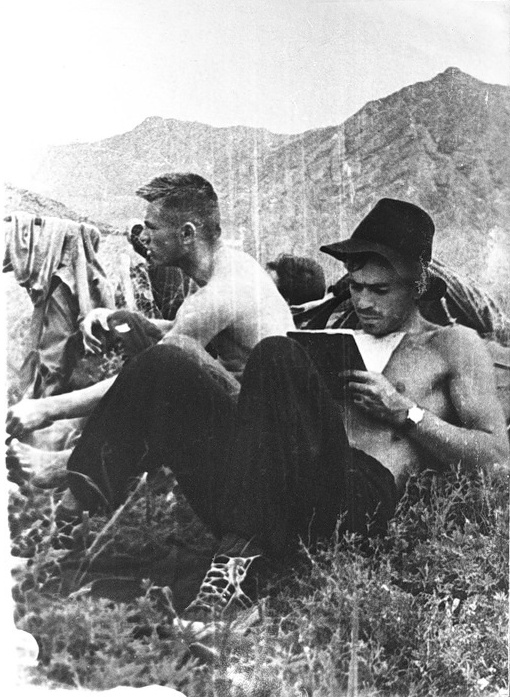
Kolya on a trek. Kolya's great grandfather was an architect, it was not by chance that Kolya was drawing maps well.
Are there any diaries or notebooks belonging to Kolya left in the family, any letters?
MEK: No.
MP: A. Rakitin asks if anything is known about whether Nikolay was left-handed or right-handed? If he was left-handed, did they retrain him to use his right hand instead?
MEK: We do not know if Kolya was left-handed or right-handed.
AE: Judging by some photographs, Kolya wore a watch on his left hand, apparently he was right handed.
MP: Did Kolya take part in the trip of the students to the Kourovka camp site to meet the New 1959 with Dyatlov and Kolevatov? This question is also from A. Rakitin.
MEK: We don't know.
MP: Y. Kuntsevich once in a conversation at the forum said that Nikolay Thibault was a Protestant, which I was very surprised. Were the Thibeaux-Brignolles Protestants, not Catholics? And in general, what was the position of the family on the question of faith, although I foresee the answer that Kolya was an atheist and a Komsomol member, like all young people at that time ... But still, was Kolya baptized, if so, in what faith? So many questions have been raised by a single replica of Y. Kuntsevich.
AE: Maya, this is a good question, I read that Kolya was a Protestant somewhere on the Internet. But this is not true!
MEK: Kolya's great grandfather, Iosif Frantsevich, grew up in a Catholic family, but he married a Lutheran, his children were baptized as Lutherans. Kolya's grandfather, Iosif Iosifovich, married an Orthodox, and all his children, including Kolya's father, Vladimir Iosifovich, were baptized in Orthodox churches (there are copies of records from the metric books).
Kolya's elder sister Elizaveta was baptized in the Orthodox church in 1916. Data on whether Kolya and his brother were baptized by Volodya, we do not. Baptizing children in the 1930s was quite dangerous for parents, in addition, in Osinniki, a mining village, at that time, apparently, there was not even an Orthodox church. In any case, Kolya could not be neither a Protestant nor a Catholic.
MP: It was dangerous, yes. But that's interesting ... For example, I learned that even in the families of Ivdel party workers, despite the disapproval of the heads of families, they were baking cakes and celebrating Easter, and grandmothers baptized their grandchildren, despite the bans of their parents. And one of the party secretaries of the Ivdel city committee of the CPSU wore an icon in the tunic throughout the war, to which his mother blessed him, escorting him to the front.
Was it accepted in Kolya's family to celebrate Easter, bake a cake, celebrate birthdays?
MEK: They did not celebrate Easter, they did not color eggs, they did not bake cakes. But birthdays were necessarily celebrated, given gifts, congratulated.
MP: How does the family look at setting up a memorial cross in the forest in the place where the bodies of the children were found?
MEK: The general opinion of the family - we think that it is necessary to put a cross. Let there be at least an approximate place of death of people marked as it was customary in our country for centuries. In this case is not even about a religious symbol only, but rather, a broader cultural tradition.
MP: Speaking of Nikolay, how would you introduce him?
AE: In the articles about the expedition and Dyatlov group Kolya is often called the son of a Frenchman or a Frenchman (for example, in a recent publication of the Komsomolskaya Pravda).
Indeed, in the inheritance from the French ancestors, Kolya received an unusual surname. The origin of Kolya, the history of the genus Thibault often raises questions. But the ancestors of Kolya remained forever in Russia, were at the service of the Russian state.
Kolya's mom - Anastasia Prohorovna - is a simple Russian woman, the daughter of a skilled worker.
So Kolya is - first of all - a Russian.
In difficult times, after his father's early death, he managed to get a high education, to become an engineer.
I would say that Kolya is a Russian Engineer - great grandson of a French architect.
MP: Dear Anna and Marina Evgenyevna, many thanks to you, and also to Sergey Evgenyevich, for share what you know about Kolya. I was very interested to learn more about him, and to be honest, it was nice to talk with you on many lyrical topics. Thanks for the new unique photos from the family history! I think that now they will no longer speak of Nicolai Thibault as a French subject and the son of a French communist. Yes, and the date of birth Kolya, perhaps, will be corrected in the records.
Yuri Yudin, on the question of whether he dreams of his deceased friends, answered that he is still dreaming of them, and then after these dreams he walks happy all day. They are all alive there. "... There is no illness, neither sorrow nor sighing, but life is endless."
I hope this publication will help readers to better know Nikolay Thibeaux-Brignolle.
Let this image of Kolya Thibault remain in our memory - a cheerful, bright, handsome young man smiling at us from the black and white photographs ...
M. P.
July - November 21.
(с) 2012